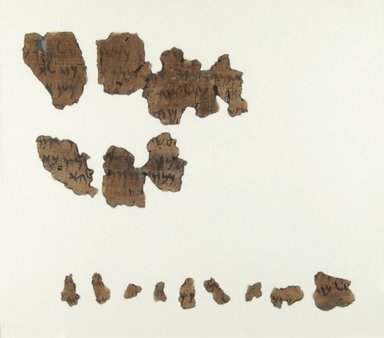
Medium: Papyrus, ink
Geograhical Locations:
Dates:402–401 B.C.E.
Dimensions: Largest Fragment: 2 9/16 × 1 13/16 in. (6.5 × 4.6 cm) 47.218.13a-1: 4 1/16 × 1 9/16 in. (10.3 × 4 cm) 47.218.13a-2: 2 1/2 × 1 3/4 in. (6.3 × 4.5 cm) 47.218.13b: 3 1/16 × 2 3/4 in. (7.7 × 7 cm) 1 3/4 x 2 3/8 in. (4.5 x 6 cm)
Collections:
Accession Number: 47.218.13a-b
Image: CUR.47.218.13b_recto_IMLS_PS5.jpg,
Catalogue Description: Seventeen papyrus fragments inscribed in Aramaic, all excepting one inscribed recto and verso. With the exception of the fragment inscribed on one side only, all these fragments apparently from one document. Unusually bold hand. Fragments do not connect. Papyrus is opisthographic. References to "corn" and to the local Egyptian god 'Khnum'. Condition: Very fragmentary. Probably impossible to obtain sense of text. Papyrus seems to be carbonized and has a texture different from others in the collection. This group of related fragments assembled from 47.218.11, 47.218.13, 47.218.15.